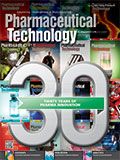Analysis and Purification: Instrumental to BioPharma
Pharmaceutical Technology Europe
To deal with the complex requirements of biopharmaceuticals, companies need a sophisticated toolbox of analytical and purification techniques.
Driven by a multitude of factors, such as an ageing population, increases in prevalence of chronic diseases, and rising adoption rates of biopharmaceuticals worldwide, the biopharma market is projected to grow rapidly over the coming years (1). A market that has developed significantly during the past three decades, the biopharma industry is also a sector that is demanding a significant evolution and sophistication in terms of purification and analytical methods.
In a special interview, Pharmaceutical Technology Europe discussed the development trends, as well as the current and future analytical technology advancements in the market, with Christian Rohrer, director of Sales & Marketing of Tosoh Bioscience-a company that is also celebrating the 30th anniversary of the European subsidiary.
Shifting focus
PTE: What major developments have you witnessed within the biopharmaceutical industry during the past three decades?
Rohrer (Tosoh Bioscience): During the past 30 years, the whole biopharmaceutical sector has been facing the same changes as the rest of the society-for example, the rise of digitalization and, even more critically, environmental and societal sustainability imperatives. To embrace these industry challenges, we believe the onus lies with ensuring people are put first, so, placing both customers and employees at the centre of every decision.
From a biopharmaceutical industry viewpoint, the shift from small molecules to large biomolecules has been noticeable. In the early years, the main biopharmaceuticals in development included insulin, growth hormones, and blood factors. Monoclonal antibodies became more of an all-rounder for multiple applications. Later on, the focus within the biopharmaceutical field shifted from a ‘monoclonal antibody only’ view to a diversification of the molecules of interest. This shift has enabled for the targeting of more specific subtypes of diseases.
However, the development of new biological drugs has become more challenging, with clearly increasing cost, regulations, and time constraints from both a financial and societal stakeholder’s standpoint. As a consequence, the whole industry has been required to be innovative and forward-looking so that it can offer exacting solutions while also keeping productivity and efficiency in mind.
A sophisticated toolbox is required
PTE: As analysis and purification are of critical importance in bio/pharma, could you elaborate on some of the analytical technological advancements that have given rise to a paradigm shift in this industry?
Rohrer (Tosoh Bioscience): Due to the greater complexity of biopharmaceuticals in comparison to small-molecule drugs, the biopharmaceutical industry requires a sophisticated toolbox of purification and analytical methods.
One example for an analytical tool in biopharma is size-exclusion chromatography (SEC). In terms of advancement in SEC, which has become an industry standard in quality control for monoclonal antibodies, expansions in capabilities have come through the development of novel columns, allowing for highly efficient ultraâhigh-performance liquid chromatography (UHPLC) analysis of protein aggregation. For downstream processing, there have been advances in high capacity packing materials, improving economies and providing more environmentally-friendly platform solutions.
Additionally, modern drug formats require stationary phases with unique selectivities for both purification and analysis, for which novel salt-tolerant ion exchange media for the purification of biomolecules, and innovative affinity media to efficiently capture antibody constructs have been introduced. Furthermore, new HPLC columns based on Fc receptors, such as FcγIIIa receptor, have been developed that allow for rapid evaluation of biologic activity and glycoform patterns of antibodies at stages when bioassays are cost-prohibitive or time-consuming.
Ensure future resilience
PTE: In the future, what technological advancements do you see as being integral for biopharma and why?
Rohrer (Tosoh Bioscience): We foresee the need of many technological advancements-both in term of products and methods-to fulfil the requirements of customers for miniaturization, automation, product safety, or regulatory evolutions.
On the one hand, the diversification of the therapeutic targets is evolving into personalized medicine, and gene- and cell-based therapies, which will become more common as the cost of techniques to develop these forms of therapies is lowering. On the other hand, the pressure on development costs and time efficiencies will inevitably rise as quicker access and cheaper cost of medications is expected from governments and patient groups, on a global scale. The opportunities and challenges to develop ground-breaking therapies while meeting expectations should motivate companies to remain at the cutting-edge of scientific and technical developments while also maintaining consistently high quality and services.
However, some upcoming transformations have not yet been identified. Therefore, flexibility and an ability to be able to react to the unexpected is important for global companies to guarantee resilience in the future. For example, Tosoh Corporation has evolved into a global enterprise based on monozukuri-a craftsman-like approach-to ensure it is prepared for new developments and challenges.
Reference
1. Allied Market Research, “Biopharmaceuticals Market by Type and Application-Global Opportunity Analysis and Industry Forecast, 2018–2025,” Market Research Report, July 2018.
Article Details
Pharmaceutical Technology Europe
Vol. 31, No. 8
July 2019
Page: 23
Citation
When referring to this article, please cite it as F. Thomas, “Analysis and Purification: Instrumental to BioPharma,” Pharmaceutical Technology Europe 31 (8) 2019.

PacBio Chosen as Tech Partner for Global Alzheimer’s Disease Research Project
April 23rd 2025The project, the North African Dementia Registry, will unite multiple entities for the purpose of developing a comprehensive dataset to advance the research community’s understanding of Alzheimer’s disease and other dementias in diverse populations.